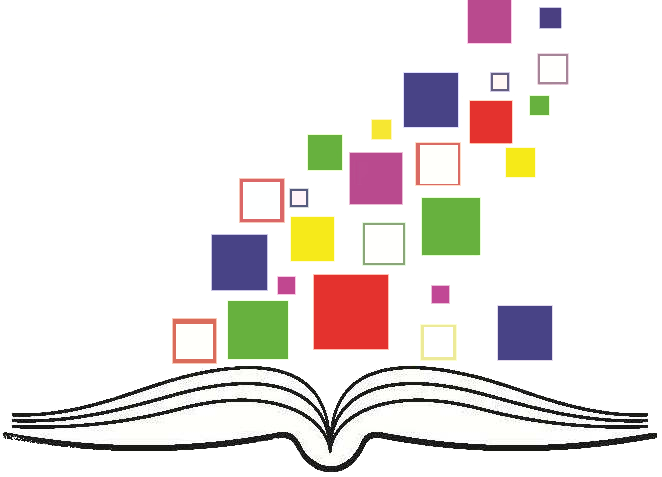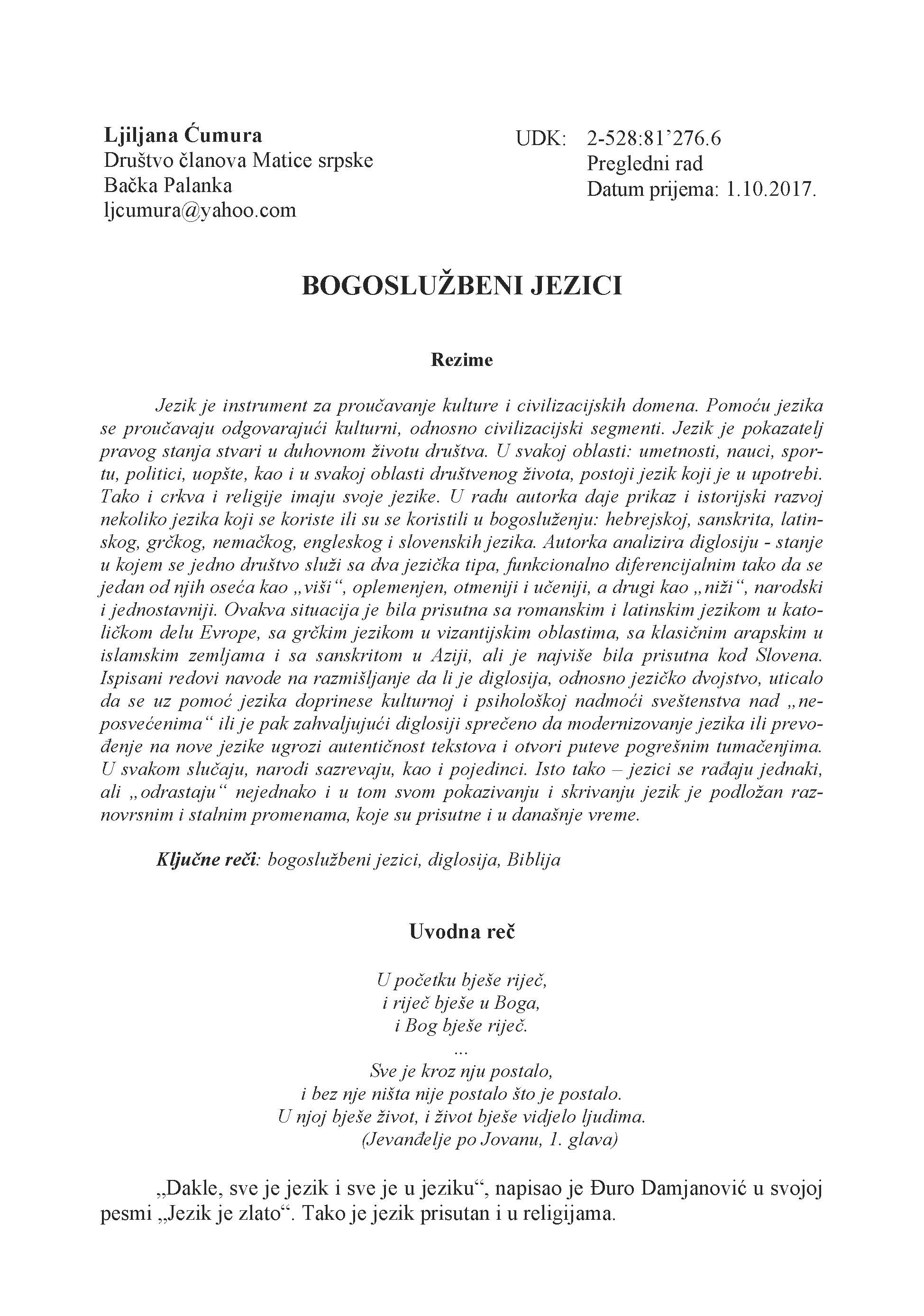Приказ основних података о документу
Bogoslužbeni jezici
Liturgical languages
| dc.contributor | Kuburić, Zorica | |
| dc.creator | Ćumura, Ljiljana | |
| dc.date.accessioned | 2024-04-16T11:31:32Z | |
| dc.date.available | 2024-04-16T11:31:32Z | |
| dc.date.issued | 2018 | |
| dc.identifier.issn | 1451-8759 | |
| dc.identifier.issn | 1821-3545 (Online) | |
| dc.identifier.uri | https://www.jevrejskadigitalnabiblioteka.rs/handle/123456789/2780 | |
| dc.description.abstract | Jezik je instrument za proučavanje kulture i civilizacijskih domena. Pomoću jezika se proučavaju odgovarajući kulturni, odnosno civilizacijski segmenti. Jezik je pokazatelj pravog stanja stvari u duhovnom životu društva. U svakoj oblasti: umetnosti, nauci, sportu, politici, uopšte, kao i u svakoj oblasti društvenog života, postoji jezik koji je u upotrebi. Tako i crkva i religije imaju svoje jezike. U radu autorka daje prikaz i istorijski razvoj nekoliko jezika koji se koriste ili su se koristili u bogosluženju: hebrejskoj, sanskrita, latinskog, grčkog, nemačkog, engleskog i slovenskih jezika. Autorka analizira diglosiju - stanje u kojem se jedno društvo služi sa dva jezička tipa, funkcionalno diferencijalnim tako da se jedan od njih oseća kao „viši“, oplemenjen, otmeniji i učeniji, a drugi kao „niži“, narodski i jednostavniji. Ovakva situacija je bila prisutna sa romanskim i latinskim jezikom u katoličkom delu Evrope, sa grčkim jezikom u vizantijskim oblastima, sa klasičnim arapskim u islamskim zemljama i sa sanskritom u Aziji, ali je najviše bila prisutna kod Slovena. Ispisani redovi navode na razmišljanje da li je diglosija, odnosno jezičko dvojstvo, uticalo da se uz pomoć jezika doprinese kulturnoj i psihološkoj nadmoći sveštenstva nad „neposvećenima“ ili je pak zahvaljujući diglosiji sprečeno da modernizovanje jezika ili prevođenje na nove jezike ugrozi autentičnost tekstova i otvori puteve pogrešnim tumačenjima. U svakom slučaju, narodi sazrevaju, kao i pojedinci. Isto tako - jezici se rađaju jednaki, ali „odrastaju“ nejednako i u tom svom pokazivanju i skrivanju jezik je podložan raznovrsnim i stalnim promenama, koje su prisutne i u današnje vreme. | sr |
| dc.description.abstract | Language is an instrument for studying culture and civilization domains. It is used to study relevant cultural or civilizational segments. Language is an indicator of the real state of things in the spiritual life of every society. In every area: arts, science, sport, politics, in general, as well as in every sphere of life, there is a language that is in use. So the church and religion have their languages. In this paper, the author gives an overview of the historical development of several languages that are used or have been used in worship services: Hebrew, Sanskrit, Latin, Greek, German, English and Slovenian language. The author analyzes diglossia - a situation in which two languages (or two varieties of the same language) are used under different conditions within a community. Diglossia means that one society serves two language types, functionally differential so that one of them felt as “higher”, refined, fancier, and more learned, and the second as “lower”, popular and simple. This situation was present with the Roman and Latin languages in the Catholic part of Europe, with the Greek language in the Byzantine areas, with classical Arabic in Islamic countries and with Sanskrit in Asia, but was mostly present in Slovenian languages. This work leads one to think that the diglossia or linguistic duality had the effect of contributing to the cultural and psychological superiority of the clergy over the unquestioned with the help of language or, thanks to the diglossia, preventing the modernization of the language or the translation into new languages by endangering the authenticity of the texts and opening the way with false interpretations. In any case, the nations mature, as well as individuals. Likewise - languages are born equal, but “grown up” is unequal, and in this display and concealment the language is subject to various and constant changes, which are present even today. | sr |
| dc.language.iso | sr | sr |
| dc.publisher | Novi Sad : CEIR ; Beograd : Institut društvenih nauka | sr |
| dc.rights | openAccess | sr |
| dc.rights.uri | https://creativecommons.org/licenses/by-nc-nd/4.0/ | |
| dc.source | Religija i tolerancija: časopis Centra za empirijska istraživanja religije | sr |
| dc.subject | bogoslužbeni jezici | sr |
| dc.subject | diglosija | sr |
| dc.subject | Biblija - jezici | sr |
| dc.subject | liturgical languages | sr |
| dc.subject | sacred language | sr |
| dc.subject | diglossia | sr |
| dc.subject | Bible - languages | sr |
| dc.title | Bogoslužbeni jezici | sr |
| dc.title | Liturgical languages | sr |
| dc.type | article | sr |
| dc.rights.license | BY-NC-ND | sr |
| dc.identifier.fulltext | http://jevrejskadigitalnabiblioteka.rs/bitstream/id/8863/BogosluzbeniJeziciOCR.pdf | |
| dc.type.version | publishedVersion | sr |
| dc.citation.spage | 133 | |
| dc.citation.epage | 147 | |
| dc.citation.issue | 29 | |
| dc.citation.volume | 16 | |
| dc.identifier.rcub | https://hdl.handle.net/21.15107/rcub_jdb_2780 |

